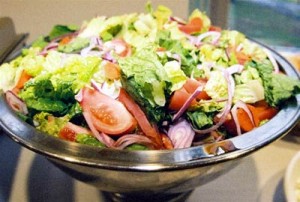 Everyone knows I love salad. I not only eat it because it’s a toothbrush for your colon, I genuinely like salad. I do not really get sick of it and I change it up all the time.
Everyone knows I love salad. I not only eat it because it’s a toothbrush for your colon, I genuinely like salad. I do not really get sick of it and I change it up all the time.
What’s your favorite stuff to put in a salad?
I found this online and think it gives some helpful advice about how to choose what sort of salad to eat:
SMART SALAD SOLUTIONS FOR SALAD LOVERS
-Try choosing only fresh vegetables, fruits, and legumes, such as kidney beans.
-Stay clear of canned fruit that is heavily laden with syrup, not too mention all those preservatives.
-Use cheese sparingly. Cottage cheese with some fresh fruit is among the better cheese choices. (I actually do not use cheese and instead dump some lo-fat cottage cheese on top of my salad for protein)
-Stay shy of too many avocados and fatty meats and eat only the egg whites of those tempting hard-boiled eggs.
-Fresh fish or grilled chicken is a great choice if available.
-For salad crunchiness, try sesame seeds or sunflower seeds over butter-fried croutons, noodles or real bacon bits.
(I put in crunchy carrots)
-Steer clear of thick and creamy salad dressings unless specified low fat. Vinegar, oil and fresh lemon are always a smart choice. (I actually keep a bottle of olive oil and balsamic vinegar at my desk so even if I have to pick up a salad at the local salad bar – I know what dressing I will be having)
-Avoid marinated vegetables with oils.
-Be aware that potato, pasta, chicken, seafood and tuna salads are more than likely loaded with oil or mayonnaise and could throw your diet into next week!
-Avoid breads, muffins and butter! Try grain breads or wheat if you absolutely must but go light.
Smart Lettuce Choices:
For years it was iceberg lettuce-which by the way is the least nutritious of lettuces- dominated the choice of salad greens. Today we see a wide-variety of lettuce blends that can attribute highly to the nutritional content needed in our daily diet. As a general rule when choosing lettuce keep in mind that the darker green or redder the leaves are means the more nutritious the salad will be.
Get away from the Iceberg doldrums and try using a variety of lettuces like: Romaine, Bibb, Red or Green Leaf, Red or Green Oak Leaf, Boston, Chicory, Escarole, Radicchio, Watercress, Arugula. The list of lettuce choices goes on and on and all mixed together makes any salad a more enjoyable one.
Try preparing your salads at home, put your dressing in a separate container, and pack in a cooler to take with you for lunch. Besides, you could get a week of healthy salads out of what you may spend on one trip to the salad bar and then you can avoid those temptations all together!
References:
Sheldon Margen, M.D., and the Editors of the University of California at Berkeley Wellness Letter, The Wellness Encyclopedia of Food and Nutrition. Health Letter Associates, 1992, p. 107-115.
One response to “Salad Smarts”
I do believe all the concepts you’ve introduced on your post.
They are very convincing and can certainly work. Nonetheless, the posts are very brief for
beginners. Could you please lengthen them a bit
from next time? Thank you for the post.